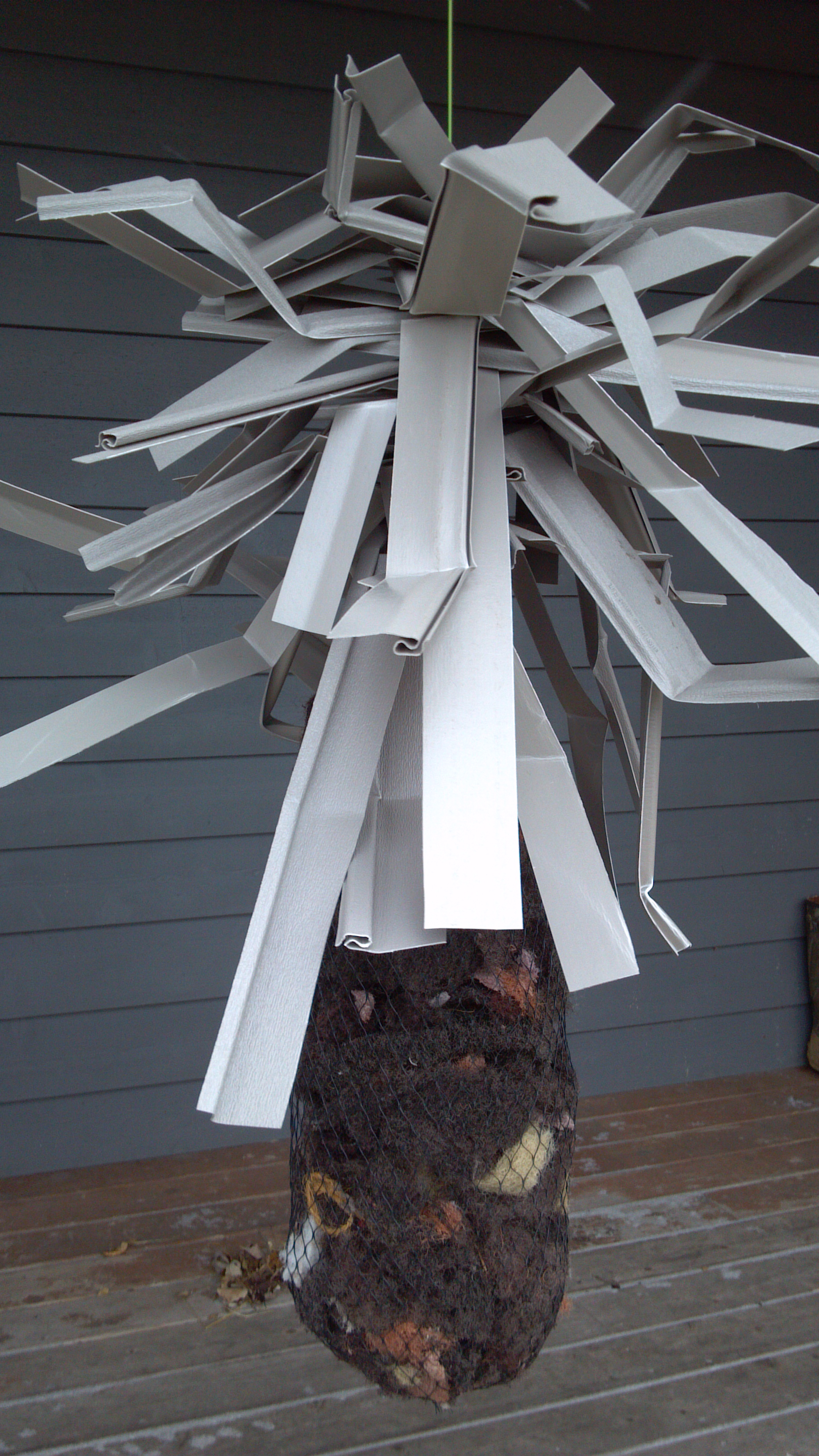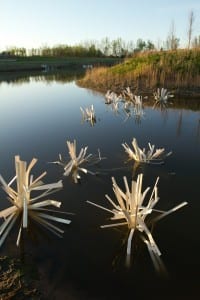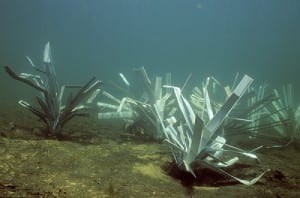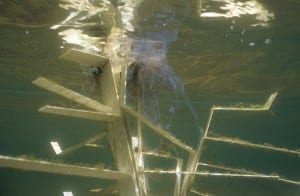|
Tag: crappie structure
Students turn Christmas trees into fish habitat
Snowflakes painted a picturesque winter scene Thursday morning throughout Demopolis.
However, the cold weather didn’t stop eager Demopolis High students, along with the Army Corps of Engineers, from working to create fish habitats along the river.
“The snow is not going to stop us,” Anne Cross, ranger said. “We are excited to come together as a community to create fish habitat.”
The students and USACE workers bundled old Christmas trees that will soon be sunk in different areas along the river. The trees make great habitats for fish like crappie.
Pieces of iron will be tied to the trees that will sink them about 10 feet or so, according to Brandon Smith from USACE.

- Various participants helped to band trees together to create fish habitats. Shown in the picture are Jason Cassity, Austin Thornbough, Brandon Smith, Marshall Thomas, Joy Snellgrove, Dakota Cunningham, Blake Bowden, Ben Sherrod and Anne Cross (kneeling).
Demopolis High school FFA club and agriculture department worked on the project.
Students in the high school FFA club and agriculture department worked on the project.
Teacher Joy Snellgrove said experience teaches students several valuable skills by granting them this hands-on experience.
“It teaches them more about conservation efforts,” she said. “Also they learn job skills and get to see other job opportunities out there.”
Students thought the project was very fun, despite Thursday’s cold weather.
“It’s fun to do something like this and help,” Dakota Cunningham, a junior said.
Cunningham said students have been learning more about reusing items in class and this project gave them a chance to get help in the community.
Later this month, there will be three boats that will go out on the river to drop the trees. The trees were all donated from people throughout Demopolis. Dozens of unique habitat models at fishiding.com
Also partnering with DHS and the USACE for the project is Alabama Power, the city of Demopolis, Tractor Supply, the U.S. Coast Guard and volunteers of Foscue Park.By Brittney Knox
All Natural Fish Feeder Never Needs Filling and Cleans Water
Product Description
Growing big fish starts with growing lots of food to feed them. In order for the fry and forage fish to thrive and reproduce, they need mass amounts of food to develop and prosper.
Minnows, small panfish and fry feed on film that grows on surfaces underwater called peripyhton. This magical micro-floral community of bacteria and fungi, protozoa and zoo-plankton, dance together forming this wonderful highly efficient, nutrient converting fish food.
Phosphorus and nitrogen are often the biggest culprits in abundant weed growth and eutrophic waters. Converting these nutrients into fish food and ultimately fish, is not new and has been being used with ongoing success sometimes called brush parks. Create the food source and the fish will come.
The more surface area available, the more food can grow. Weed beds are a good example of surfaces for this film to grow and hiding places for the small fish.
The Hangout is where the smaller fish will congregate and eat this highest form of food available, within the protection of the maze of vinyl limbs that surround the feeder bag.

The plastic mesh feeder bag holds an incredible 400 square feet of surface area from a matrix of woven plastic recycled from drinking bottles. Weighing just over two pounds and approximately ten inches diameter and two feet long, these bags hold the key to fish development.
Over thirty two square feet of flexible vinyl limbs, the same material in all fishiding fish habitat products, complete this protective eating establishment. Dozens of unique habitat models at fishiding.com
Bend limbs and pinch crease with fingers, no tools or additional supplies needed.
Opens to a full 46″wide by 48″ tall, hang at any depth, unit sinks.
Each unit comes with 5.5 pounds of pre-drilled vinyl limbs, ranging in length from 12″-28″ long and 1″-4″ wide with feeder bag with ten feet of mono bait-ball line.
Hang unit from underside of dock or pier for year around fishing action.
Suspend unit from raft or tree limb to keep predators close by your food source.
Attach unit to full size habitat unit or anchor and add foam to feeder bag to add buoyancy.
Tie multiple units together for deep water applications.
Solitude Lake Management Educates Clients about the importance of Fish Habitat and cover
David Beasley, head Fisheries Biologist for Solitude Lake Management talks about the need for fish habitat for a balanced aquatic environment. Fishiding.com and Solitude Lake Management have been working closely together to help clients up and down the East coast improve water quality and fish habitat. Beasley has been a strong leader in helping lake and pond owners understand the multiple benefits of adding and improving fish habitat in their waters. Dozens of unique habitat models at fishiding.com
Together, working with numerous Federal and State agencies , private lake owners, lake management associations and DNR Biologists, habitat restoration and improvement is near the top of everyone’s list.
Artificial fish habitat made from PVC, never decay and only improve with time. Un-like wood, plants and natural products that decay over time and remove dissolved oxygen from the water, bio film and periphyton growth adhere to PVC, creating nature’s finest available food for fry development. This magical film excels in nutrient uptake, converting over abundant phosphorus, nitrogen and other nutrients from the water brought in from run-off fertilizer, and plant decay. This inert substrate allows algae growth all year long, providing this important “mother’s milk” of small fish development.
Check out all the products available on-line at fishiding.com or Solitude Lake Management and see why the Industry Leader’s are leading with fishiding artificial Fish habitat Products.
Artificial fish habitat programs boost reputation of GRDA lakes
Professional Angler sees the benefits of GRDA programs …
Langley – Although February 2013 will mark the first time that the Bass Master Classic tournament has visited Grand Lake, that does not mean participating fishermen will be unfamiliar with the popular fishing waters. Dozens of unique habitat models at fishiding.com
Grand Lake is always among the most popular angler destinations in Oklahoma and the surrounding region. Its 46,500 acres of water offer plenty of locations and plenty of room for landing the big one or just passing the time and wetting a hook.
 Volunteers gather for instructions from the GRDA Ecosystems Management Department during a “Rush For Brush” event held in the Spring of 2012. Local anglers – both casual and professional – have seen the benefits of this GRDA program and other fisheries enhancement efforts on Grand and Hudson lakes.
Volunteers gather for instructions from the GRDA Ecosystems Management Department during a “Rush For Brush” event held in the Spring of 2012. Local anglers – both casual and professional – have seen the benefits of this GRDA program and other fisheries enhancement efforts on Grand and Hudson lakes.Still, in recent years, the Grand River Dam Authority Ecosystems Management Department has been very active in lake-enhancement programs designed to both protect and preserve the waters of Oklahoma’s third-largest reservoir. The department was established in 2004 and has stayed busy with efforts like aquatic plant transplant programs, new oversight efforts for fishing tournaments and the very popular “Rush For Brush” artificial fish habitat effort. In late November the department also announced the first annual “Crappie Christmas” program to collect used live Christmas trees after the holidays for use at fish habitats.
“Our ‘Rush For Brush’ program is one of the most popular things we do,” said GRDA Fisheries Coordinator Brent Davis. “We seem to get more and more volunteer interest every year and it’s been very successful.”
GRDA’s efforts at fisheries enhancement have not been lost fishing enthusiasts – even those who do it professionally. Edwin Evers (Talala, Oklahoma), who will compete in the upcoming Bassmaster Classic knows the waters of Grand Lake well and also knows what it’s like to help with the GRDA’s artificial fish habitat efforts.
“The coolest thing they do to manage these lakes is they have this Rush For Brush,” said Evers. “This where volunteers come out and build habitats with materials supplied by GRDA, then fishermen can put them where they want to in the water. It’s just another thing GRDA does to make our lakes so great.”
All that habitat does make a difference in angler success. Each year, the Oklahoma Department of Wildlife Conservation (ODWC) releases an Oklahoma Bass Tournaments Annual Report. In the most recent report, with numbers from 2010, Grand Lake ranks third to continue “its annual showing at or near the top of our list,” states the ODWC report. In past years, GRDA’s Lake Hudson has also been a frequent visitor to the top 10 list. In other words, a standard answer to the age-old question “where are they biting?” can almost always be “Grand and Hudson.”
Meanwhile, GRDA’s efforts to help manage catches at all those tournaments are also good for the lakes, said Evers.
“The other thing I think makes a big difference in why Grand Lake is so good is how GRDA manages the summer months,” said Evers. “During those times when fish are caught deep and water temperatures are really high, they limit the amount of fish that can come in during a tournament. They go from a five fish limit to a four fish limit in June and July. Then, they take it to a three fish limit in August when it’s the absolute hottest. When you do that, there is a lot less stress on the fish.”
All those efforts help GRDA to meet not only its ecosystems management mission but they also aid the economic development mission. A good tournament reputation helps bring in more tournaments, which bring in more dollars to the lake area. Of course, the upcoming Bassmaster Classic has the reputation as the biggest and most prestigious of all.
Davis, who works closely with tournament officials on GRDA lakes, said larger, more prestigious tournaments like the Classic equal even more money spent per angler, per day.
“I am going to say $300 to $400 per day,” he said, pointing out that those numbers are just for the anglers themselves, and do not include the dollars spent by the fans who attend the events.
All those people will get to experience one of the best lakes to be found, said Evers.
“When I think of Grand, what pops in my mind is one of the premier lakes in the country,” he said. “It’s as good as it possibly gets.”
With a continued focus on good management practices, and ongoing programs that involve lake-area stakeholders, GRDA is working to keep it that way.
Headquartered in Vinita, GRDA is Oklahoma’s state-owned electric utility; fully funded by revenues from electric and water sales instead of taxes.
Directly or indirectly, GRDA’s low-cost, reliable; electricity serves nearly 500,000 homes in Oklahoma and stretches into 75 of 77 counties in the state. At no cost to Oklahoma taxpayers, GRDA also manages 70,000 surface acres of lakes in the state, including Grand Lake, Lake Hudson and the W.R. Holway Reservoir. Today, GRDA’s 500 employees continue to produce the same “power for progress” that has benefited the state for 75-plus years.
Leaser lake fish habitat in place and ready for water
Leaser Lake to begin refilling
 The dam at Leaser Lake in Lynn Township has undergone major upgrading after the lake was drained for repairs. Man made fish habitats dot the interior of the lake bed. (Douglas Kilpatrick, SPECIAL TO THE MORNING CALL / February 12, 2012) The dam at Leaser Lake in Lynn Township has undergone major upgrading after the lake was drained for repairs. Man made fish habitats dot the interior of the lake bed. (Douglas Kilpatrick, SPECIAL TO THE MORNING CALL / February 12, 2012) |
Lehigh Valley anglers and boaters received very welcome news late last week when the state Department of Environmental Protection gave the final approval to begin refilling Leaser Lake in northwestern Lehigh County.
According to the Pennsylvania Fish and Boat Commission, the refilling process will begin in mid-December, and the 117-acre lake will be stocked with trout in time for the regional opening day of trout season on Saturday, March 30, 2013. Dozens of unique habitat models at fishiding.com
“This is great news for all the anglers, boaters and outdoor enthusiasts who use the lake and have been waiting patiently for the project to be completed,” said PFBC Executive Director John Arway. “Rebuilding a dam is a big project which requires cooperation between state agencies, local officials and the public.”
Leaser Lake, originally constructed with a dam in 1971, has now been rebuilt three times because of leakage issues. This latest repair had the lake drawn down in 2009 for the repair project, which included the addition of man-made and natural fish habitat structures to help the new population of fish that will be stocked in the lake.
“The long-term plan is to stock the lake with fingerlings from various warm-water species, like bass, crappie, blue gills and yellow perch, and allow those fish to grow over the next several years into a sustainable fishery,” said Dave Miko, the chief of the PFBC Division of Fisheries Management.
“The short-term plan is to stock adult trout in the lake this spring so anglers can get back on the water and enjoy their sport. As long as the lake is about half-full, and anglers can safely access the water, we’ll stock trout for the opener
Refilling the lake, which sits on approximately 526 acres of public land owned by the state and Lehigh County, will take some time. Rainfall will help fill the lake, but levels will also be determined by PFBC engineers, who plan on raising the water level two feet per week while monitoring the dam for any problems until it is full.
The $3.5-million repair project included a $500,000 contribution from Lehigh County, while the Leaser LakeHeritage Foundation raised funds to help pay for the fish habitat structures in conjunction with PFBC work.
Also contributing to the price tag were grants for $750,000 from the Department of Conservation and Natural Resources’ Community Conservation Partnerships, $500,000 from DEP, and $300,000 form PFBC’s Growing Greener II program.
In addition to the lake itself, local Boy Scout troops and school districts helped formalize a trail system around the lake, which is on the south side of the Blue Mountain.
Pennsylvania Game Commission Executive Director Carl G. Roe will appear on Pennsylvania Cable Network’s live “PCN Call-In” program at 7 p.m. on Thursday, Nov. 15. Viewers of the hour-long program can call in questions to PCN toll-free at 1-877-726-5001.
PFBC asks for your help: The Pennsylvania Fish and Boat Commission is extremely concerned about the politics being played with the federal budget in Congress.
If a federal budget is not passed before the end of the year, money due from the Sport Fish Restoration Program and the Boating Safety Trust Fund — collectively called the Trust Funds — would be withheld and the Trust Fund would incur a 7.6 percent cut, approximately $43 million to all state fish and wildlife agencies in 2013
“The projected financial impact of losing 7.6 percent of Pennsylvania’s portion of the Trust Funds in 2013 — $859,000 — means that we will have to reduce services to Pennsylvania anglers and boaters,” said Arway, the PFBC executive director.
“However, I believe the greater violation is the breach of trust between the anglers, boaters and businesses [that] pay the tax and the federal government which plans to withhold the funds from the states.”
Congress passed the Budget Control Act in 2011 that mandated automatic spending cuts to reduce the deficit, and unless a budget agreement is reached, those cuts will go into effect Jan. 2, 2013.
The money allocated to the Trust Funds comes directly from excise tax dollars levied on fishing tackle, equipment and motorboat fuels, not funds collected from income tax.
“The Trust Funds are the lifeblood of the Pennsylvania Fish and Boat Commission’s day-to-day efforts to restore and manage fisheries and their habitats; open and maintain recreational access for all; and keep the public safe by providing boating safety education,” said PFBC Deputy for Administration Brian Barner.
“If budget sequestration takes effect, our agency will have to make tough decisions now and down the road. Potentially, we may have to reduce services like fish stocking, access area maintenance, boating education and safety, and other programs which Pennsylvania’s anglers and boaters care about deeply.”
The Gramm-Rudman-Hollings Act of 1985 provided that excise tax revenue going to the Trust Fund would be exempt from budget sequestrations, but a loophole exists because the Act did not specific that money from the Trust Funds was exempt from sequestration withholding.
The PFBC is asking concerned anglers, boaters and outdoors lovers to ask members of the U.S House of Representatives and U.S. Senators Bob Casey and Patrick Toomey to exempt the Sport Fish Restoration Program and Boating Safety Trust Fund and keep the trust with America’s sportsmen and women. To contact your U.S. Senator or Congressman, contact the U.S. Capitol switchboard at 202-224-3121 or visithttp://www.house.gov or http://www.senate.gov.Gary BlockusGary Blockus
National Fish Habitat Partnership Releases Updated Action Plan to Conserve America’s Aquatic Resources

The new, second edition of the National Fish Habitat Action Plan advances science-based conservation mission and incorporates new objectives focused on locally driven efforts to reverse deteriorating fish habitats.

National Fish Habitat Action Plan, Second Edition
Washington, DC (PRWEB) August 29, 2012
The National Fish Habitat Board today released the second edition of the National Fish Habitat Action Plan (Action Plan), setting forth a mission-critical approach to conserving the nation’s aquatic resources for the future. The original National Fish Habitat Action Plan, created in 2006, carried a great vision forward to protect, restore and enhance aquatic habitats through partnerships. While the original Plan met its objectives set forth in 2010, the mission and goals of the plan remain the same and are the foundation of the second edition of the Plan for 2012 and beyond.
The second edition of the National Fish Habitat Action Plan is built on the foundation of advancing the conservation practices of the individual National Fish Habitat Partnerships, the working units of the National Fish Habitat Partnership. The five new objectives in the Plan include:
- Achieve measurable habitat conservation results through strategic actions of Fish Habitat Partnerships that improve ecological condition, restore natural processes, or prevent the decline of intact and healthy systems leading to better fish habitat conditions and increased fishing opportunities.
- Establish a consensus set of national conservation strategies as a framework to guide future actions and investment by the Fish Habitat Partnerships by 2013.
- Broaden the community of support for fish habitat conservation by increasing fishing opportunities, fostering the participation of local communities – especially young people – in conservation activities, and raising public awareness of the role healthy fish habitats play in the quality of life and economic well-being of local communities.
- Fill gaps in the National Fish Habitat Assessment and its associated database to empower strategic conservation action supported by broadly available scientific information, and integrate socio-economic data in the analysis to improve people’s lives in a manner consistent with fish habitat conservation goals.
- Communicate the conservation outcomes produced collectively by Fish Habitat Partnerships as well as new opportunities and voluntary approaches for conserving fish habitat to the public and conservation partners.
The second edition of the Action Plan details how the new objectives will be implemented. The Plan also highlights conservation “Partnership in Action” stories from Fish Habitat Partnerships to provide insight into their work on the ground. Other sections explain the functions of the National Fish Habitat Board and Partnerships and the critical role of science and data and effective communications to guide activities. Interesting facts and figures related to the National Fish Habitat Partnership, recreational and commercial fishing fill out the rest of the Plan. See the dozens of unique habitat models at fishiding.com
“The revised Action Plan is built on the success and experiences of our Partners,” said Kelly Hepler, Chairman of the National Fish Habitat Board and Assistant Commissioner, Alaska Department of Fish and Game. “Creating and maintaining these Partnerships is the foundation of the Action Plan and will be the primary focus as we address conservation needs for our nation’s waterways now and into the future.”
The National Fish Habitat Board, Fish Habitat Partnerships, federal and state natural resource agencies, conservation organizations and the National Fish Habitat Partner Coalition participated in the selection process of the revised Plan objectives. The release of the revised Action Plan coincides with the launch of the updated National Fish Habitat Partnership website at http://www.fishhabitat.org.
To view and download a PDF of the revised Action Plan, visit http://www.fishhabitat.org/images/nfhp_ap_final.pdf.
About the National Fish Habitat Partnership
The National Fish Habitat Partnership (http://www.fishhabitat.org) works to conserve fish habitat nationwide—leveraging federal, state and private funding sources to achieve the greatest impact on fish populations through priority conservation projects. The national partnership implements the National Fish Habitat Action Plan and supports 18 regional grassroots partner organizations.
Texas tree top habitat causes Govenor intervention.
Dear friends,
I was recently contacted by J Harmon, President of the Protect lake Dunlap association in New Braunfels,Texas. He explained to me their struggle with the Guadalupe-Blanco River Authority over existing small diameter standing timber being hazardous to recreation use. Apparently, The GBRA has denied the cutting of these stumps to protect fish habitat and recommends marking these areas off to boat use which has the residents upset.
See the dozens of unique artificial fish habitat models, fish attractors and fish cover at fishiding.com, the leader in proven science based, fish protection.
The PLDA’s plan is to draw down the reservoir and shorten the existing hazards about eight feet from normal surface elevation. I’m told there are hundreds of them and already have caused many accidents and property damage. J says the average depth is about 15 feet, so when cut, they would still stick up about 6-8 feet off the bottom, root ball intact.
After cutting, they plan to set one of our PVC habitat units on the remaining stump and fasten it there for good. This would increase the square footage of surface area approximately three times. The thinking is, with our units within six feet of the surface as water fluctuates, boats, skiers and water craft will be safe, including the fish. J and the group understand the benefits of not only keeping as much existing habitat as possible but to continue to add more habitat. The cut off tops would be kept and fastened to the remaining trunk too.
They have a full understanding of the science behind periphyton, nutrient removal and fish production and feel unwavering in their decision to work with only us in their efforts.
Senator Jeff Wentworth supports PLDA. With his intervention and the phone call from Gov. Rick Perry, GBRA’s action item #8 was tabled. The PLDA has been granted 30 days, (less now) to present their case for a final decision of what will be allowed. The General Manager and staff continue to meet with representatives of Lake Dunlap, enforcement officers, and fishery experts to evaluate the current no-wake area designation and alternative options to provide water safety and assure a balance of all uses including the preservation of fishery habitat and funding mechanisms, and to continue to review and develop alternatives that address congestion and lake boating conflict uses on Lake Dunlap and to report back to the Board at its next regularly scheduled meeting in August 2012.
What I’m asking of you once again is your opinion, hopefully your support. Can you find any adverse effects of removing these hazardous stumps as long as the habitat is replaced in other ways/forms? Can you comment on the benefits of the artificial habitat we produce and results you have seen? What can we expect to see in a 300 % increase in available cover for the fishery? With our help, the PLDA intends to present their plan for approval as a landmark decision for the state of Texas. Safety for the residents and fish is the priority of both sides, in that order. All parties involved want to save and increase fish habitat. Wood is good, just not where people get hurt. Send replies to either Jarod or myself at david@fishiding.com Thanks.
Here are some links to the information as well as Jerod Harmon’s contact information:
news story:
http://www.ksat.com/news/Lake-Dunlap-res…rz/-/index.htmlhttp://www.plda.org/index.htmlhttps://docs.google.com/viewer?url=http%3A%2F%2Fwww.plda.org%2Ffiles%2Fstump_removal_procedure.pdfhttp://www.gbra.org/
jrharmon123@yahoo.com
713-202-8870
Fish habitat crusader awarded Churchill Fellowship
Craig Copeland – working to save our fish habitat. Image NSW DPI
CRAIG Copeland, Manager of the Conservation Action Unit within the NSW Department of Primary Industries (DPI) has been awarded a prestigious Churchill Fellowship to investigate the motivation of recreational fishers in the US, UK and Ireland to restore fish habitat.
“Craig, who is based at Wollongbar, is highly regarded throughout Australia for his work in aquatic habitat rehabilitation,” said NSW DPI Director General Richard Sheldrake.
“He has led the pioneering unit responsible for fish habitat rehabilitation in NSW which has resulted in massive improvements to fish habitat and fish populations through initiatives such as fishway construction, weir removals, fish-friendly road crossings, floodgate management, riparian revegetation and river resnagging programs.”
Copeland’s work in educating and engaging the broader recreational fishing community on habitat issues is proving successful with some of the larger recreational fishing groups through the establishment of the Fish Habitat Network program.
Dr Sheldrake said the Fellowship will provide an opportunity for Mr Copeland to travel to countries in the Northern Hemisphere where recreational fishing groups and individual fishers are the principal players in restoring fish habitat. See the dozens of unique artificial fish habitat models, fish attractors and fish cover at fishiding.com, the leader in proven science based, fish protection.
“By interviewing fishers in these countries, Craig will get to understand their motivations and capacities – and bring back expertise aimed at increasing the capability of Australian recreational fishers to support and improve their fishery.
“The lessons learned will be immediately transferred to recreational fishers and habitat managers here in NSW.”
Copeland said the sustainability of recreational fishing and the capacity of the sector to grow are dependent on healthy fish stocks.
“Over three million people fish recreationally each year making it one of the most significant outdoor activities undertaken by Australians,” he said.
“There is great scope to significantly increase the proportion of recreational fishers in NSW who contribute time, funding and effort to rehabilitate fish habitat and, as a result, increase fish populations.”
Copeland plans to undertake his Fellowship trip in early 2013 and will report back to the
recreational fishing community later in the year.
The Winston Churchill Memorial Trust, which was established after the death of Sir Winston
Churchill in accordance with his final wishes, has now funded more than 3,700 Fellowships for Australians. http://www.fishingworld.com.au/news/fish-habitat-crusader-awarded-churchill-fellowship




